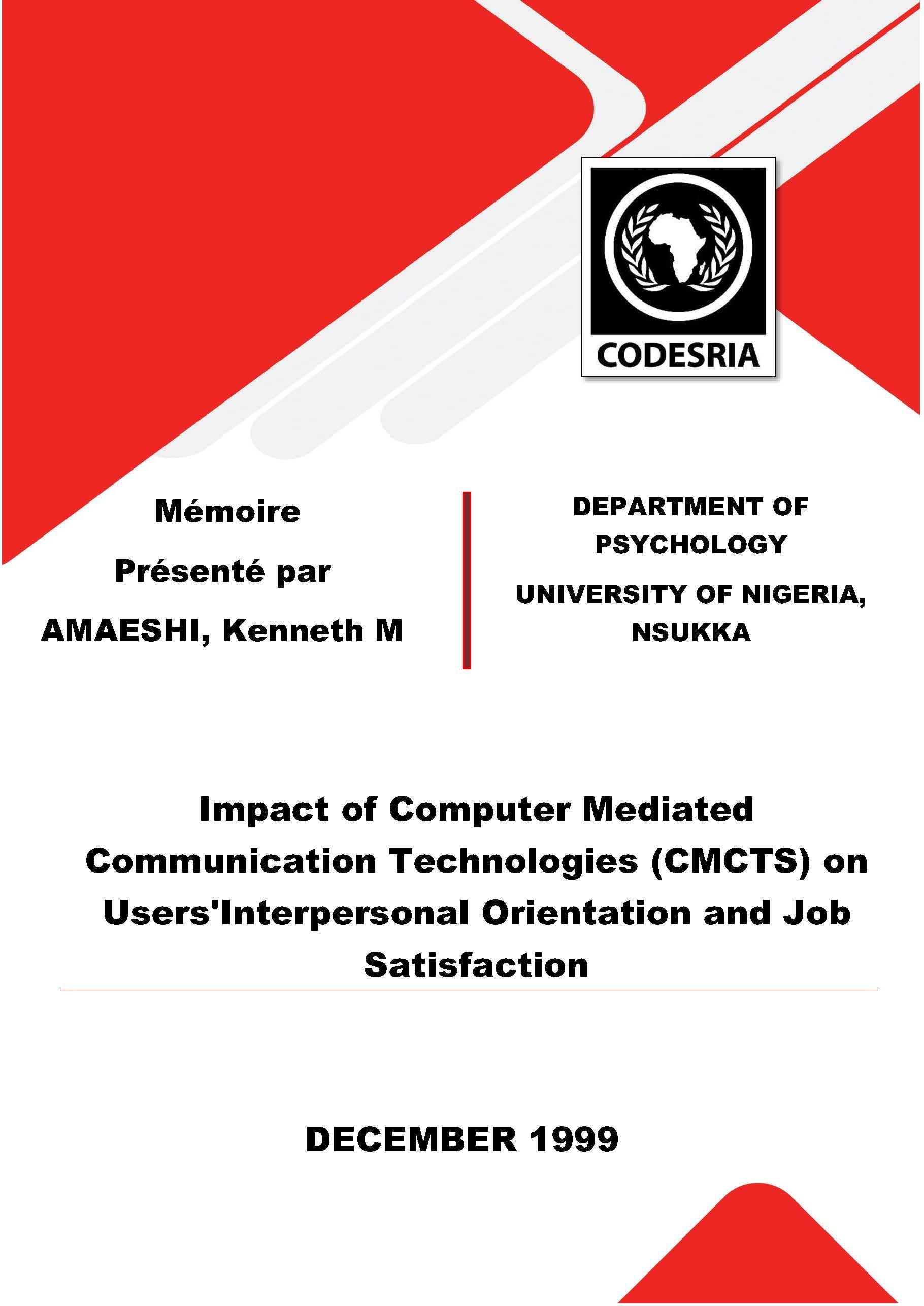IMPACT OF COMPUTER.MEDIATED . OMMUNICATION TECHNOLOGIES (CMCT) ON USERS' INTERPERSONAL ORIENTATION AND JOB SA TISF ACTION
Keywords:
Computer Conferencing, Communication engineering, Job Satisfaction, Communication SystemsSynopsis
This study investigated the impact of Computer-Mediated Communication Technologies (CMCTs) on user's Interpersonal Orientation (10) and Job Satisfaction GS). The Job Description Index GDI) and the Interpersonal Orientation Scale (IOS) were used to measure participants' JS and 10, respectively. A total of 300 participants (186 males, 114 females, 148 CMCTs users, 152 non-users, 141 senior staff and 159 junior staff) drawn from Shell Petroleum Development Company (SPDC), Elf Petroleum, Diamond Bank Limited, and Citizens Bank Limited all in Port Harcourt, Rivers State were used for the study. The major instrument for data collection was the questionnaire. MAN OVA statistics were used for the analysis of data.
Downloads
References
Albertson, L. A. (1977). Telecommunications as a travel substitute: Some psychological, organizational, and social aspects. Journal of Communication, 27(2), 32-43.
Argyle, M. (1967). The p.rychology of inte,personal behaviour. Harmondsworth: Penguin.
Attewell, P. (1987). The de-skilling controversy. Work and Occupations, 14(3), 323-346.
Bandura, A. (1986). Social foundation of thought and action: A social cognitive theory. Englewood Cliffs, NJ: Prentice-Hall
Barber, R. E. & Lucas, C. H., Jr. (1983). System response time, operator productivity, and job satisfaction. Communication of the ACM, 26(11), 972-986.
Baron, R. A., & Byrne, D. (1987). Socialp.rychology: Understanding human interaction. London: Allyn and Bacon, Inc.
Baroudi, J. J., & Ginzberg, M. J. (1986). Impacts of the technological environment on programmer/ analyst job outcomes. Comm. of the ACM, 29(6), 546-554.
Bartol, K. M. (1983). Turnover among DP personnel: A causal analysis. Comm. of the ACM, 26(10), 807-811.
Bass, B. M., & Ryterband, E. C. (1979). Organizational p.rychology. (2nd ed.) London: Ally and Bacon, Inc.
Birks, G. (1980). Electronic mail - Its use in a corporate information centre network. In: A. R. .
Benenfeld & J. Edwards (Eds.), Communication Ieformation, Proceedings of the American Society for Information Science (ASIS) 43rd Annual Meeting, 17, 41-43.
Bush, W.R. (1990). Telecommuting: The case of research software development. Technological Forecasting and Social Change, 37, 235-250.
Caldwell, D. E., & O' Reilly, C. A., III. (1982). Task perceptions and job satisfaction: A question of causality. Journal of Applied P!)chology, 67, 361-369 Coates, J. F. (1991). Science, technology, and human rights. Technological Forecasting and Social
Change, 40, 389-391.
Crandall, J. E. (1980). Alder's concept of social interest: Theory, measurement, and implications for adjustment. Journal of Personality and Social P!)chology, 39, 481-495.
Crider, A. B., Goethals, R. G., Kavanaugh, R. D. & Solomon, P.R. (1983). P!Jchology. NJ: Scott.
Dance, F. E. X. (1967). Toward a theory of human communication. In: F. Dance (Ed.), Human communication theory. NY: Holt, Rinehart and Winston.
DeMan H. (1929). J qy in work. NY: Henry Holt Duncanson, J. P., & Williams, A. D. (1973). Video conferencing: Reactions of users. Human
Factors, 15, 471-486.
Ellis, M. V., & Haase, R. F. (1987). Multivariate analysis of variance. Journal of Counseling P!)chology, 34(4), 404-413.
Ewen, R. B. (1967). Weighting components of job satisfaction. JAP, 51, 68-73.
Finn, T. A. (1986). Process and structure in computer-mediated group communication. In: B.
Ruben, (Ed.) Information And Behaviour, 2, New Brunswick, NJ: Transaction Books.
Hay kin, S. (1992). Communication systems, civilian. In: R. A. Meyers (Ed.) Enryclopedia of pf?ysical science and technology, 3.
Herzberg, F., Mausner, B., & Snyderman, B. (1959). The motivation to work. NY: John Wiley & Sons.
Hiltz, S. R., Johnson, K.., Aronovitch, C., & Turoff, M. (1980). Equality, dominance and group decision-making: Results of a controlled experiment on face to face vs. computer-mediated discussions. In: J. Salz (Ed.) Computer Communications: Increasing benefits far society: Proceedings This Project of the 5th International conference on computer communication, Oct. 27-30, Atlanta, GA.
Amsterdam, The Netherlands.
Hiltz, S. R., & Turoff, M. (1985). Structuring computer-mediated communication systems to avoid information overload. Communications of the ACM, 28(7), 680-689.
Hulin, C. L., Drasgow, F., & Komocar, J. (1982). Applications of item response theory to analysis of attitude scale translations. JAP, 67(6), 818-825.
Hunter,]. E., & Schmidt, F. L. (1983). Quantifying the effects of psychological interventions on employee job performance and work force productivity. Amen'can P.rycho!ogist, 38, 473-478. ·
Huseman, R. C., Lahiff, J. M., & Hatfield, J. D. (1976). Inte,personal communication in organizations.
Boston: Holbrook Press, Inc.
Ivancevich, J. M., Napier, H. A., & Wetherbe, J. C. (1983). Occupational stress, attitudes, and health problems in the information systems professional. Communications of the ACM, 26(10), 800-806.
Johansen, R., & DeGrasse, R. (1979). Computer-based teleconferencing: Effects on working patterns. Journal of Communications, 29(3), 30-41.
Johnson, S. M., Smith, P. C., & Tucker, S. M. (1982). Response format of the job descriptive index: Assessment of reliability and validity by the multi-trait-multi-method matrix. JAP, 67, 500-50.
Kahneman, D, & Tversky, A. (1979). Prospect theory: An analysis of decisions under risk.
Econometrica, 47, 262-291.
Kerr, E. B., & Hiltz, S. R. (1981). Cognitive impacts of computer-mediated communication systems upon individuals. In: L. F. Lunin, M. Henderson, & Harold, W. (Eds.) The information commtmiry: An alliance far progress. Proceedings of the American Society for
Information Science (ASIS) 44th Annual Meeting, 18, Oct. 25-30, Washington, DC: White Plains, NY: Knowledge Industry Publications, 232-234.






